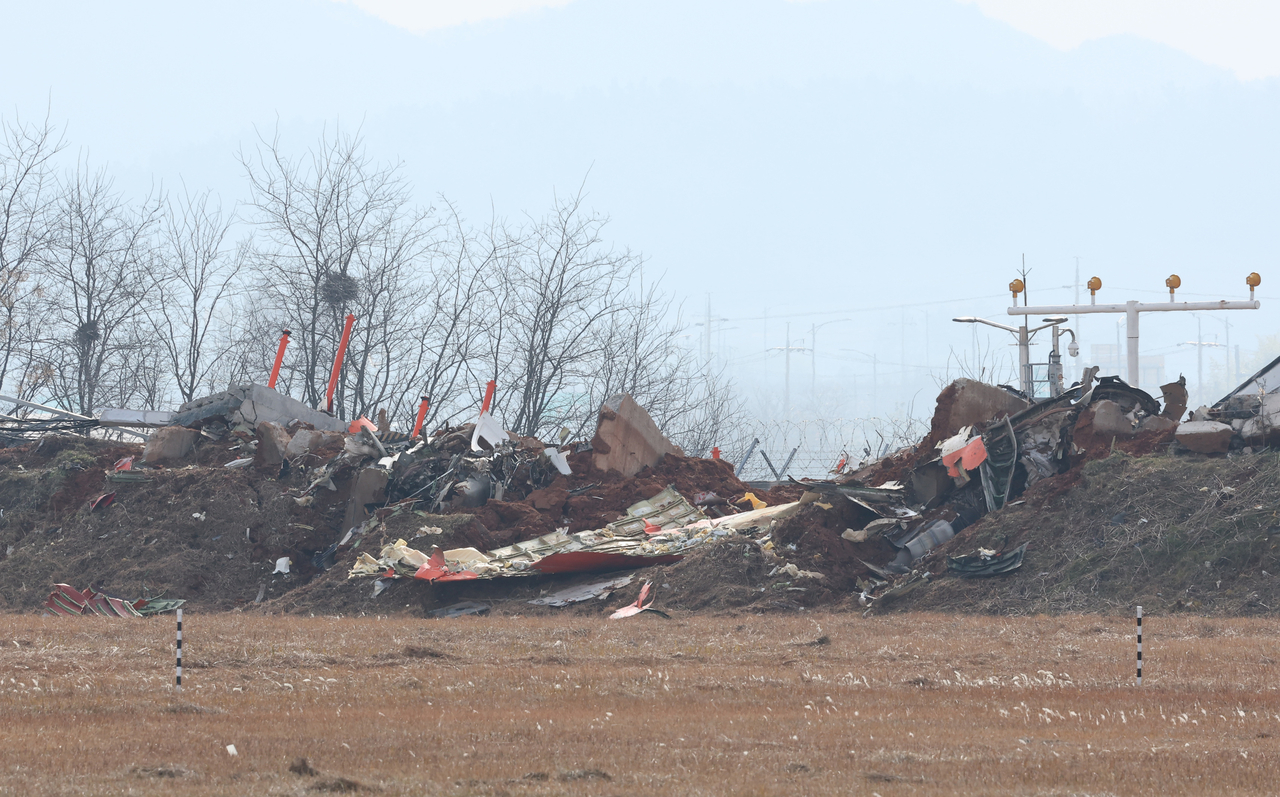
The wreckage of Jeju Air flight 7C 2216 is seen at Muan International Airport in South Jeolla Province on Monday. (Yonhap via The Korea Herald/Asia News Network)
Sunday’s deadly plane crash set off a wave of concern over birds disrupting the safe operations of flights, with a bird strike suspected as the possible cause behind one of the deadliest aviation tragedies in South Korean history.
In the aftermath of Jeju Air flight 7C 2216’s crash, it was revealed that a government-commissioned report in 2020 had warned the government of bird strike issues for Muan International Airport in South Jeolla Province, the site of the accident that left 179 dead of the 181 passengers and crew.
The report specified there is “substantial danger of bird strike when an airplane takes off or lands” at the airport, and called for a measure to reduce such risks. The report was conducted to evaluate the environmental effects of a government plan to extend the airport’s runway from 2,800 meters to 3,160 meters by 2025.
READ: All but 2 feared dead after South Korea plane crashes with 181 aboard
It specified that Muan International Airport is near the known habitat of migrating birds, and that the newly extended runway overlaps with the birds’ migration route. The research revealed that three known habitats were adjacent to the airport, with two on-site inspections finding 1,278 birds and 1,760 birds in the area, respectively.
Muan is not the only airport near habitats of migrating birds, as similar issues ail Gimpo International Airport in Seoul, Busan’s Gimhae International Airport and even Incheon Airport, the main gateway to the country.
This is due to the fact that birds prefer areas that are optimal for long-distance flight, which coincides with being suitable for commercial flight, according to a 2020 Korea Environment Institute report on risk management for bird and plane collisions.
“Airplanes and birds share a common trait of ‘flight,’ which means an optimal place for an airport is also an optimal place for (migratory) birds to live,” the report stated.
READ: What we know about Jeju Air plane crash in South Korea
Some portion of the land where Incheon Airport is located used to be mudflats, populated by many migrating birds. As such, construction of the airport faced concerns about malicious effects on the environment.
Over two decades after the airport opened, birds and airplanes share the airspace over the airport, causing considerable safety risk.
Bird strikes on the rise
There has been an increase in the number of cases of birds colliding with airplanes in recent years.
Birds collided with airplanes in 623 occasions from 2019 to the first half of this year, according to government data revealed by Rep. Jeon Yong-gi of the main opposition Democratic Party of Korea. The number went from 108 in 2019 to 76 in 2020 — when air traffic decreased drastically due to the COVID-19 pandemic — and rose back to 109 in 2021, before further rising to 131 in 2022 and 152 in 2023.
For Muan International Airport specifically, there have been 10 cases since 2019, not counting Sunday’s accident, the cause of which has not been confirmed yet. It had among the fewest bird strikes out of all airports in South Korea, but its 11,004 flights in that period were also far fewer than other bigger airports.
By percentage, 0.09 percent of all flights at Muan International Airport were subject to a bird strike from 2019, which is the highest out of all the airports. In comparison, flights at Jeju International Airport stood a 0.013 percent change of colliding with a bird, while Gimhae International Airport sat at 0.018 percent in the same period.
Only two of the confirmed bird strike cases this year across the country had actually led to any damages, and both cases had no associated deaths, according to Korea Airports Corp. But bird strikes could completely cripple a plane, as evidenced by the 2009 midair collision of US Airways flight 1549 with a flock of birds in New York, better known as the “Miracle on the Hudson” that ended with pilot “Sully” Sullenberger landing the plane with no fatalaties on the Hudson River.
A mourner cries while paying respects to victims of Sunday’s Jeju Air flight 7C 2216 crash, at a joint memorial in Muan, South Jeolla Province, Monday. (Yonhap via The Korea Herald/Asia News Network)
Not enough monitoring for bird strikes at Muan?
Ministry of Land, Infrastructure and Transport regulations state that a single runway operated for nine hours or less requires a minimum of four officials for the purpose of preventing bird strikes by shooing away nearby birds. A commercial airport with fewer than 5,000 flights a year can reduce that number to two, as in the case of Muan International Airport.
But the Herald Business newspaper reported that only one person was working on bird strike prevention duties at Muan at the time of the accident. A Korea Airports Corp. report shows that the airport has four people for the job, divided into three teams working in shifts.
The number of officials allocated to bird strike prevention duties at the airport in Muan is substantially smaller than the reported 40 at Incheon, 23 at Gimpo and 20 on Jeju Island.
The Transportation Ministry is currently conducting an investigation into determining the exact cause behind the crash of Jeju Air flight 7C 2216, which killed 179 of the 181 people onboard. While it is unclear if a bird strike was responsible for the crash, possibly lax bird monitoring at Muan International Airport is suspected of contributing to the tragedy.

